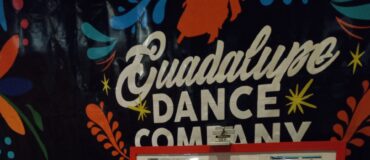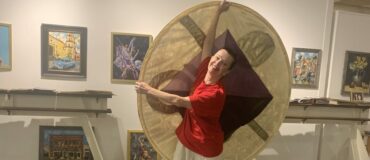By Amy Schofield
Amy Schofield is a 2024 Archiving and Preservation Fellow with the National Institute of Flamenco. Read more about the Fellowships here. This is the first part of Amy’s blog.
Dance, Music, Family, and Community in the “Land of Enchantment”
The office of the National Institute of Flamenco (NIF) was abuzz as I walked in on my first day. The organization was in the final stages of planning the 37th annual Festival Flamenco Alburquerque.[1] Founded in 1982 by Eva Encinias, the National Institute of Flamenco is a pillar of the Albuquerque community. NIF consists of multiple overlapping branches of programming that provide flamenco music and dance education and local performances to children and adults. Eva’s daughter, Marisol Encinias, is NIF’s current executive director. Eva’s son, Joaquín Encinias, is the artistic director of Yjastros: The American Flamenco Repertory Company, the professional dance company associated with the institute and founded in 2002. Yjastros presents two seasons per year with performances featuring works by Joaquín and choreographers from Spain. As a repertory company, NIF considers Yjastros a “living archive of choreographic masterworks”. Members of the company also perform weekly at local tablaos (flamenco performance venues), and they interact regularly with the nearby University of New Mexico’s Department of Theatre and Dance. Lastly, the annual flamenco festival that NIF hosts and organizes is the largest and most celebrated flamenco festival outside of Spain, drawing in thousands of flamenco professionals and aficionados to the area each year for ten days of performances, workshops, and youth programming.
Flamenco is a form of music and dance that originated in Andalusia, the southernmost region of Spain, in the mid-19th century. While flamenco has roots in Sephardic Jewish music, Islamic instrumentation and singing, African-diasporic percussive dance, Anglo-Iberian folk dance, and more, it is the Spanish Roma who have had the largest influence on flamenco’s development. Known for its dynamic percussive footwork and intricate guitar accompaniment, flamenco has flourished in New Mexico for generations. I lived in Albuquerque for three years while completing my MFA in flamenco choreography at The University of New Mexico (UNM), so I was already familiar with NIF and the larger Albuquerque flamenco community. I was excited to dive deeper into the history of flamenco in the region, especially since one of the most unique things about NIF is its intergenerational legacy and familial flamenco oral tradition. It truly is a family affair. Marisol’s great grandmother, Juanita López, was born in Andalusia, Spain and immigrated to New Mexico where her daughter Clarita García de Aranda was born in 1919. It was Clarita who taught Eva Encinias and later Marisol and Joaquín, whose own children are involved in the organization. Because of NIF’s familial ties to flamenco, I knew that this project would require open communication and care, as these records and ephemera are not merely from a dance organization but filled with close family history and love.
I am a dancer and dance researcher. I perform, teach, and research flamenco and flamenco communities in the US. I have some practical experience with archiving and archival research, but little formal training. Due to flamenco’s rich history in Albuquerque, with which I am already familiar, and flamenco’s complex bodily, rhythmic, and melodic structured improvisational communication, I am excited to apply my unique expertise to the ways I’m working to preserve NIF’s archival materials.

Photo of NIF’s archival materials on my first day of work.
On my first day, I was given a tour of the facility. NIF has existed in numerous locations over the years, and their archive seems to be spread between their current office location; the homes of Marisol, Joaquín, and Eva; and the small library in UNM’s dance building that doubles as the shared graduate student office. Additionally, in 2013, a devastating fire destroyed the building that NIF once called home on Gold Street in downtown Albuquerque. Not only did the organization need to find a new location, but much of their records, photos, and costumes were lost, creating the intense desire to preserve the remaining ephemera and artifacts from the school, company, and family.
During the first few days of my Fellowship, I performed an archival assessment, approximating the number of photographs, newspaper clippings, videotapes, cassette tapes, vinyl records, programs, posters, etc. I also talked with NIF’s employees about their desires and priorities for the archive in order to set a plan for the summer. NIF’s ultimate goal is to digitize much of their collection and make it available to dance researchers, but the first step is figuring out exactly what they have.

Flyer for a flamenco juerga (performance/jam session) with an image of Albuquerque-based flamenco dance elder Lili del Castillo from 1991.
I was surprised by how much of the work had already been done. Over the years, a number of interns and employees had slowly been chipping away at digitization and organization of the archive. Continuity seemed to be the main roadblock, as no manual, controlled vocabulary, or conventions were previously established, which meant each new set of eyes and hands had to re-invent the wheel. The inventory spreadsheet that already existed was extensive, listing much of the ephemera that had already been digitized. It did not double as a finding aid, however, so I was unable to use it to locate specific items listed within it. In fact, it was easier to work in the other direction. I could often locate the newspaper clipping I held in my hand on the inventory, but locating a specific item using the inventory proved next to impossible.
Another of NIF’s priorities is to conduct oral history interviews with local flamenco artists. While the archive on-site was smaller than I had anticipated, much of the flamenco knowledge and history within the area is held within the memories of community elders like Eva Encinias and dancer Lili del Castillo. It’s a surreal experience to dig deeper into the web of flamenco in the United States and how the artform has developed in this region over the last 40 years of NIF’s existence, and even before. I’ve seen videos and photographs of dancers, teachers, and musicians from 20+ years before I met them or worked with them, which has brought endless smiles to my face. It has also been exciting to look through videos of past flamenco festivals while participating in this year’s festival, which is in full swing as I write this blog post.

Banner for the 37th Annual Festival Flamenco Alburquerque outside of the University of New Mexico’s Carlisle Gym, where many of the dance workshops for the festival are held.
As I’m diving into the flamenco history of this region and see names and faces of my mentors and idols, I recognize that preserving this dance history means being in touch with my own dance history and upholding a legacy that I myself am a part of as a flamenco artist and researcher. For me, this project is much more than preserving the history of a dance organization. As a former student of Marisol and Eva, I feel a genuine closeness to this project. While my name doesn’t appear in the archive (except as archivist), I feel a connection to the work because of my position as a flamenco artist who works, creates, learns, and lives in this ecosystem — one that has a long a history that Eva, Marisol, and Joaquin have fought their entire lives to sustain. As I continue the work this summer, I’m looking forward to growing as an archivist, but I’m also looking forward to deepening my relationship with flamenco in the Land of Enchantment.
[1] The festival purposefully uses the city’s original Spanish spelling. The extra “r” in “Alburquerque” is intended to connect the event Spanish heritage and flamenco in the city.
Header image: Eva Encinias with her company Ritmo Flamenco. Photo by Douglas Kent Hall.
All other images courtesy of the author.

Amy Schofield (she/her) is a doctoral candidate in Dance Studies at The Ohio State University. She is a flamenco dancer, scholar, educator, and choreographer whose research explores the development and evolution of flamenco in the diaspora. Her dissertation analyzes the ways Latinx flamenco artists in the US can use their flamenco practice and performance as a decolonial praxis that mobilizes and reinterprets the percussive artform to reflect and serve Latinx communities. Amy holds an MFA in Dance from the University of New Mexico and a BFA in Dance from the University of the Arts (Philadelphia, PA). She has studied flamenco extensively in Spain and the US, and she regularly teaches and performs with U Will Dance Studio, The Flamenco Company of Columbus, and Caña Flamenca in Columbus, OH.
Photo credit: Elliot Archuleta
____
We accept submissions on topics relevant to the field: advocacy, artistic issues, arts policy, community building, development, employment, engagement, touring, and other topics that deal with the business of dance. We cannot publish criticism, single-company season announcements, and single-company or single artist profiles. Additionally, we welcome feedback on articles. If you have a topic that you would like to see addressed or feedback, please contact communications@danceusa.org.
Disclaimer: Opinions expressed in guest posts do not necessarily represent the viewpoints of Dance/USA.






